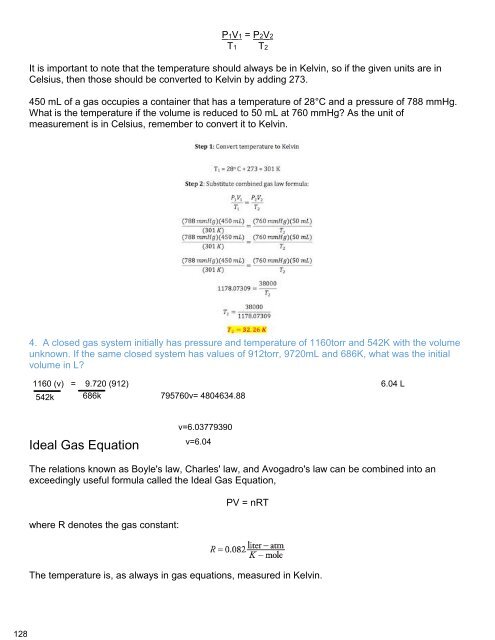Create successful ePaper yourself
Turn your PDF publications into a flip-book with our unique Google optimized e-Paper software.
It is important that you realize that pressure and volume vary inversely; therefore, an increase in<br />
either one necessitates a proportional decrease in the other.<br />
Convert a pressure of 611 mm Hg to atmospheres.<br />
.794Atm<br />
1. If a gas at 1.13 atm pressure occupies 732 milliliters, what pressure is needed to reduce the<br />
volume to 500 milliliters?<br />
(1.13) 732 = n (500)<br />
827.16 = 500p<br />
2 atm<br />
1.65432= P<br />
2=p<br />
Charles' Law<br />
In 1787, the French inventor Jacques Charles, while investigating the inflation of his man‐carrying<br />
hydrogen balloon, discovered that the volume of a gas varied directly with temperature. This relation<br />
can be written as<br />
V1 = V2<br />
and is called Charles' law. For this law to be valid, the pressure must be held constant, and the<br />
temperature must be expressed on the absolute temperature or Kelvin scale.<br />
T1<br />
Because the volume of a gas decreases with falling temperature, scientists realized that a natural<br />
zero‐point for temperature could be defined as the temperature at which the volume of a gas<br />
theoretically becomes zero. At a temperature of absolute zero, the volume of an ideal gas would be<br />
zero. The absolute temperature scale was devised by the English physicist Kelvin, so temperatures<br />
on this scale are called Kelvin (K) temperatures. The relationship of the Kelvin scale to the common<br />
Celsius scale must be memorized by every chemistry student:<br />
T2<br />
K = °C + 273<br />
Therefore, at normal pressure, water freezes at 273 K (0°C), which is called the freezing point, and<br />
boils at 373 K (100°C). Room temperature is approximately 293 K (20°C). Both temperature scales<br />
are used in tables of chemical values, and many simple errors arise from not noticing which scale is<br />
presented.<br />
Use Charles' law to calculate the final volume of a gas that occupies 400 ml at 20°C and is<br />
subsequently heated to 300°C. Begin by converting both temperatures to the absolute scale:<br />
T1 = 20°C = 293.15 K<br />
T2 = 300°C = 573.15 K<br />
125



